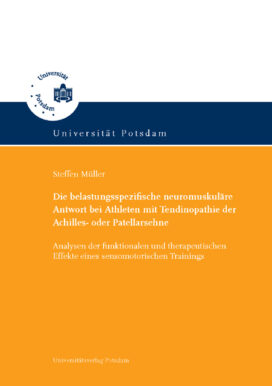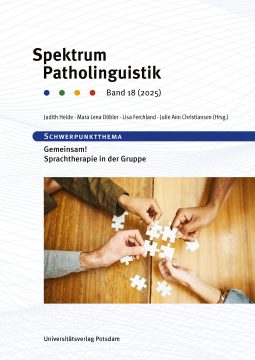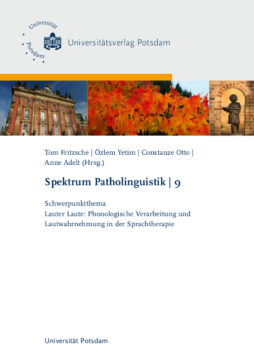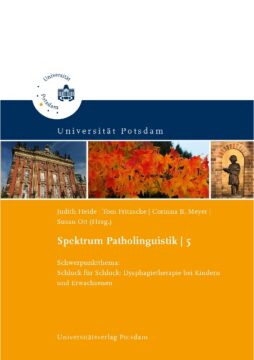Tendinopathies of the achilles- or patellartendon are common overuse unjuries in sports including high numbers of repetitive stretch-shortening-cycles of the lower limb. Possible alterations of the neuromuscular response (NMR) to physical stress and functionally justified therapies with potential positive effects are currently unknown.
The aim of the study was therefore the analysis of the neuromuscular response in situations with physical stress in athletes with tendinopathie of the achilles or patellartendon compared to symptom free athletes. In addition, possible functional and therapeutic effects of a sensorimotor training were studied in a prospective, randomized and controlled study. 51 athletes with unilateral tendinopathy (achilles-/patellartendon n=35/16) and 33 healthy athletes were included to assess the stress related neuromuscular response (NMR). To clarify the effects of a sensorimotor training 26 athletes with tendinopathy were randomized to a control group (n=14) and a therapy group with sensorimotor training (n=12). After initial biomechanical measurements M1 (situations: running, active postural stability and maximum strength test) and the collection of subjective complaints (pain) an 8-week treatment phase followed with a final re-test M2 measure identical to M1. The sensorimotor training was arranged for the entire lower extremity, and was checked after an initial briefing on a regular basis. The assessment of the NMR was quantified by muscle activity (EMG). In addition, the kinetics (e.g. maximum force) was acquired in the stabilization and maximum strength test.
A reduced NMR could be proven for athletes with tendinopathy with changed EMG time and amplitude measurements, a reduced active postural stabilization ability and reduced maximum strength (p <0.05). No relevant differences could be observed in comparing localization (achilles-/patellartendon) and side (leg with complains/healthy leg). The sensorimotor training showed an optimization of NMR (e.g. increased maximum strength) for patient with tendinopathy of the achilles- or patellartendon. The examination of the complaints showed reduced values in all pain scores after therapy. The treatment had therefore positive therapeutic effects compared to the control group. In summary, a systematically reduced NMR in running, stabilization and strength tests are evident for athletes with tendinopathy. The sensorimotor training can be considered as an efficient treatment with functional and therapeutic effects.
Analysen der funktionalen und therapeutischen Effekte eines sensomotorischen Trainings
ISBN: 978-3-940793-18-8
139 pages
Release year 2008
7,00 €
Non-taxable transaction according to § 1 (1) UStG/VAT Act in combination with § 2 (3) UStG/VAT Act a. F. Providing this service, the University of Potsdam does not constitute a Betrieb gewerblicher Art/Commercial Institution according to § 1 (1) No. 6 or § 4 KStG/Corporate Tax Act. If the legal characterization of our business is changed to a commercial institution subsequently, we reserve the right to invoice VAT additionally. zzgl. Versandkosten
Tendinopathies of the achilles- or patellartendon are common overuse unjuries in sports including high numbers of repetitive stretch-shortening-cycles of the lower limb. Possible alterations of the neuromuscular response (NMR) to physical stress and functionally justified therapies with potential positive effects are currently unknown.
The aim of the study was therefore the analysis of the neuromuscular response in situations with physical stress in athletes with tendinopathie of the achilles or patellartendon compared to symptom free athletes. In addition, possible functional and therapeutic effects of a sensorimotor training were studied in a prospective, randomized and controlled study. 51 athletes with unilateral tendinopathy (achilles-/patellartendon n=35/16) and 33 healthy athletes were included to assess the stress related neuromuscular response (NMR). To clarify the effects of a sensorimotor training 26 athletes with tendinopathy were randomized to a control group (n=14) and a therapy group with sensorimotor training (n=12). After initial biomechanical measurements M1 (situations: running, active postural stability and maximum strength test) and the collection of subjective complaints (pain) an 8-week treatment phase followed with a final re-test M2 measure identical to M1. The sensorimotor training was arranged for the entire lower extremity, and was checked after an initial briefing on a regular basis. The assessment of the NMR was quantified by muscle activity (EMG). In addition, the kinetics (e.g. maximum force) was acquired in the stabilization and maximum strength test.
A reduced NMR could be proven for athletes with tendinopathy with changed EMG time and amplitude measurements, a reduced active postural stabilization ability and reduced maximum strength (p <0.05). No relevant differences could be observed in comparing localization (achilles-/patellartendon) and side (leg with complains/healthy leg). The sensorimotor training showed an optimization of NMR (e.g. increased maximum strength) for patient with tendinopathy of the achilles- or patellartendon. The examination of the complaints showed reduced values in all pain scores after therapy. The treatment had therefore positive therapeutic effects compared to the control group. In summary, a systematically reduced NMR in running, stabilization and strength tests are evident for athletes with tendinopathy. The sensorimotor training can be considered as an efficient treatment with functional and therapeutic effects.
Recommended Books
-
 2025
2025Judith Heide, Mara Lena Döbler, Lisa Ferchland, Julie Ann Christiansen, Vibeke Masoud, Katrin Eibl, Tina Braun, Nitza Katz-Bernstein, Paula Ambrus, Cilly Hubert, Jonka Netzebandt, Laura-Jane Bur, Stefanie Jung, Tilo Mentler, Jenny Griffel, Sven Karstens, Hannah Singh, Simon Werker, Bingjia Yan, Paulina Harnisch, Ulrike Frank, Rebekka Echternkamp, Isabel Neitzel
Schwerpunktthema: Gemeinsam! Sprachtherapie in der Gruppe
Non-taxable transaction according to § 1 (1) UStG/VAT Act in combination with § 2 (3) UStG/VAT Act a. F. Providing this service, the University of Potsdam does not constitute a Betrieb gewerblicher Art/Commercial Institution according to § 1 (1) No. 6 or § 4 KStG/Corporate Tax Act. If the legal characterization of our business is changed to a commercial institution subsequently, we reserve the right to invoice VAT additionally.
Read more -
 2016
2016Anne Adelt, Tom Fritzsche, Constanze Otto, Özlem Yetim
Schwerpunktthema: Lauter Laute
10,50 €Non-taxable transaction according to § 1 (1) UStG/VAT Act in combination with § 2 (3) UStG/VAT Act a. F. Providing this service, the University of Potsdam does not constitute a Betrieb gewerblicher Art/Commercial Institution according to § 1 (1) No. 6 or § 4 KStG/Corporate Tax Act. If the legal characterization of our business is changed to a commercial institution subsequently, we reserve the right to invoice VAT additionally.
zzgl. Versandkosten
Add to cart -
 2019
2019Susanne Voigt-Zimmermann, Karl-Heinz Stier, Thomas Lascheit, Stephanie A. Kruse, Maria Blickensdorff, Theresa Förster, Rebecca Schumacher, Frank Burchert, Irene Ablinger, Christine Förster, Michael Wahl, Irene Schirmacher, Frank Ostermann, Lisa-Marie Welke, Ulrike Frank, Lilla Zakariás, Christos Salis, Isabell Wartenburger, Ragna Krug, Hanna Stübner, Judith Heide, Sophie Hoffmann
Schwerpunktthema: Gut gestimmt
8,50 €Non-taxable transaction according to § 1 (1) UStG/VAT Act in combination with § 2 (3) UStG/VAT Act a. F. Providing this service, the University of Potsdam does not constitute a Betrieb gewerblicher Art/Commercial Institution according to § 1 (1) No. 6 or § 4 KStG/Corporate Tax Act. If the legal characterization of our business is changed to a commercial institution subsequently, we reserve the right to invoice VAT additionally.
zzgl. Versandkosten
Add to cart -
 2012
2012Corinna Meyer, Susan Ott, Judith Heide, Tom Fritzsche
Schwerpunktthema: Schluck für Schluck
7,50 €Non-taxable transaction according to § 1 (1) UStG/VAT Act in combination with § 2 (3) UStG/VAT Act a. F. Providing this service, the University of Potsdam does not constitute a Betrieb gewerblicher Art/Commercial Institution according to § 1 (1) No. 6 or § 4 KStG/Corporate Tax Act. If the legal characterization of our business is changed to a commercial institution subsequently, we reserve the right to invoice VAT additionally.
zzgl. Versandkosten
Add to cart
Publisher Info
Contact
Potsdam University Library
University Press
Am Neuen Palais 10
14476 Potsdam
Germany
verlag@uni-potsdam.de
0331 977-2094
0331 977-2292





